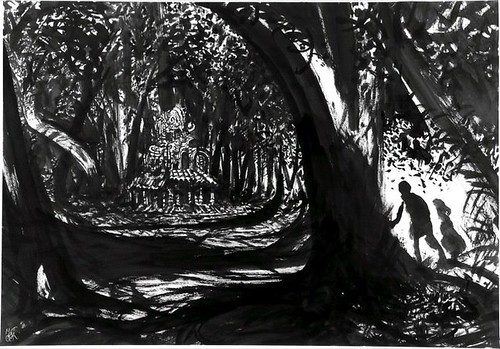
Behind the scenes at Oberlin Opera Theater
››› September 26, 2013 | Posted By Daniel McGrew
It is THAT time of year again, folks!
*Drum roll, please*
That's right, Humperdinck's HÄNSEL UND GRETEL and all of its musical splendor will grace the stage this fall in Oberlin's Hall Auditorium, and just in time for the Holiday season!
SHAMELESS MARKETING TIME!
Buy your tickets in advance HERE!
Get them while they're hot! (Fresh out of the OVEN hot, along with all those cookies and cakes you probably shouldn't be eating because a HEXE (a "witch" in German) IS LITERALLY GOING TO EAT YOU.)
If you're reading this blog post, and thinking something along the lines of:
"I really don't know about the story of Hänsel and Gretel and I'm a little disturbed that I was just told I was going to be eaten by a German witch... and I happen to be gluten free so I don't eat cookies and cake...also, don't tell me what to do, they seriously pay you to write this blog?"
Ahem.
Even if you weren't thinking any of those things... Let's clear the air on the actual story of Hänsel und Gretel!
Contrary to popular belief, Hänsel and Gretel is not an adorable fable filled with sugar, spice, and everything nice. If you have never seen the classic Bugs Bunny rendition of the story, I advise you to take a gander at the video below:
As silly as this version is, Hänsel and Gretel at its origin is far more sinister, and carries themes that are definitely not as sweet...
In the original Grimm's fairy tales rendition, Hänsel and Gretel are the children of a poor wood cutter. Fearing starvation, the wood cutter's wife--the children's step-mother--convinces him to lead the children into the forest, and abandon them there. Hansel and Gretel hear her plan, and gather white pebbles, to leave themselves a trail home. After their return, their stepmother again convinces the wood cutter to abandon them; this time however, they can only leave a trail of breadcrumbs. Unfortunately, the various animals of the woods eat their trail of breadcrumbs causing Hansel and Gretel to become lost.
Lost in the forest, they find a house made of bread (later versions call it gingerbread.) The inhabitant of the house, an old woman, invites them in and prepares a feast for them. The woman, however, is a witch who has built the house to entice children to her, so that she may fatten and eat them. She cages Hänsel, and makes Gretel her servant. While she prepares to boil Hansel, she tells Gretel to climb into an oven to be sure it is ready to bake; but Gretel knows that the witch intends to bake her as well, and tricks the witch into climbing into the oven, closing it behind her.
Taking jewels from the witch's house, they set off for home to be reunited with their father, whose wife has since died.
The tale is a sanitized version for middle class consumers of the 19th century, but the original was an admonishment of the hardships of Medieval life. Because of constant hunger and shortages of food, infanticide was a common practice in the Middle Ages, and in this story brother and sister are left in the woods to die or disappear because they cannot be fed.
Errm.... yikes!?!?
Remind me never to get lost in the middle of the woods EVER. Uff-da.
Now brace yourselves...without giving away all the details...Oberlin's opera version this fall will indeed lean on the dark side of the tale, making this particular production possibly inappropriate for kiddos under 12.
Stay tuned for more surprises in the coming weeks! Posts to come about the production, cast, music, and design process for this truly fabulous, (and scary) show!
Illustration by Lorenzo Mattotti
Oberlin College & Conservatory | 77 W College Street, Oberlin, Ohio 44074 | 440-775-8200 | Directories | Search


Responses To This Entry:
Leave A Comment: